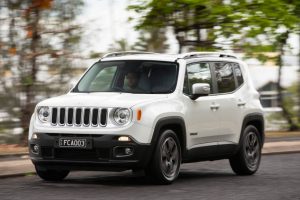Recalls: Jeep BU Renegade
Overview
Manufacturers, or importers, issue recalls for defects or faults which have the potential to cause injury. Generally, manufacturers will inform the original buyers if their vehicle is subject to a recall and of the steps required to remedy the defect or fault. Please note that the recalls below (if any) are for Australian-delivered vehicles only. Furthermore, the number of recalls should not be taken as an indication of a model’s reliability or its safety more generally.
Recalls: Jeep BU Renegade
2015 Jeep BU Renegade: vehicle may lose power
In September 2016, a recall was issued for 2015 Jeep BU Renegade vehicles because the transaxle wiring harness may have been manufactured with insufficient wire terminal crimp(s) – this could cause an intermittent high electrical resistance in the transaxle wire harness circuit(s). As a result, the vehicle may lose motive power and pose an accident hazard for the driver and other road users. Furthermore, a high resistance circuit(s) in this wiring harness could cause the on-board diagnostic system to log a Diagnostic Trouble Code (PRA 2016/15624).
2015-16 Jeep BU Renegade: Park Assist may not bring vehicle to rest
In January 2016, a recall was issued for 2015-16 Jeep Renegade vehicles because the ‘Park Assist’ mode may not bring the vehicle to a complete stop – this could pose a hazard to the driver, pedestrians and other road users. To fix, ‘Park Assist’ mode required a software update (PRA 2016/15169).
Problems and faults: Jeep BU Renegade
Overview
This section identifies potential problems, causes and fixes based on the experiences of owners and repairers, online sources and technical service bulletins. This information is provided solely for reference purposes and AustralianCar.Reviews recommends that only properly qualified persons carry out repairs or modifications. Furthermore, the number of items below should not be taken as an indicator of a model’s reliability or the frequency with which they may occur.
To report a problem or fault to the AustralianCar.Reviews team, please use the Contact Us form. Note that AustralianCar.Reviews does not offer advice on automotive problems or disputes; such enquiries will not receive a reply. For vehicles purchased from dealers after 1 January 2011, please see our Australian Consumer Law fact sheet.
2015 Jeep BU Renegade: steering wheel vibration
In October 2015, Jeep issued Technical Service Bulletin 07-007-15 for Jeep BU Renegade vehicles that were manufactured prior to 26 May 2015 and were not fitted with a transmission skid plate. In these vehicles, the driver may notice a vibration in the steering – this was caused by clearance between the radiator anchoring pin and radiator support rubber bushing. To fix, aluminium foil adhesive tape was to be applied to each radiator support bracket and wrapped around the left round anchoring pin to increase pin diameter. For details, please refer to the service bulletin.
2015 Jeep BU Renegade 2.4L with automatic transmission:
In September 2015, Jeep issued Technical Service Bulletin 21-030-15 REV A for Jeep BU Renegade vehicles that had 2.4-litre ‘Tigershark’ petrol engines and nine-speed 948TE automatic transmissions. In these vehicles, the Malfunction Indicator Lamp (MIL) may illuminate and the following Diagnostic Trouble Codes (DTCs) may be recorded:
- P0711 – Transmission Fluid Temperature Sensor A Circuit Range-Performance;
- P1DAD – Input Shaft-Output Shaft Direction Correlation;
- P1CC9 – Unable to Engage Gear;
- P1D98 – Incorrect Gear Ratio Clutch B or D Defective; and,
- U1424 – Implausible Engine Torque Signal Received.
To fix, the Transmission Control Module (TCM) was to be re-programmed with updated software.
The updated software also included the following enhancements:
- Improved shifts from park or neutral to drive or reverse;
- 1-2 shift quality improvements;
- Improved engine performance under certain operating conditions (high altitude, high ambient temperatures and high humidity);
- Hill shift pattern optimisation;
- Improved redline shift performance; and,
- Improved upshifts, downshifts, coast down shifts and tip shifts.




